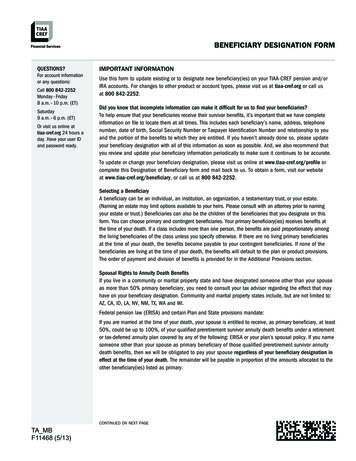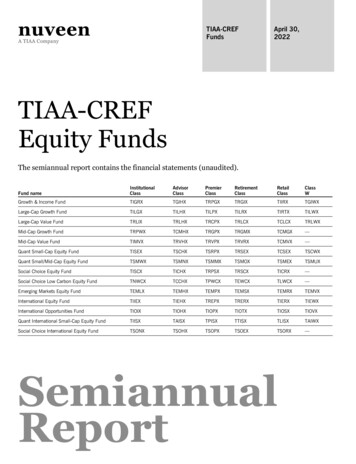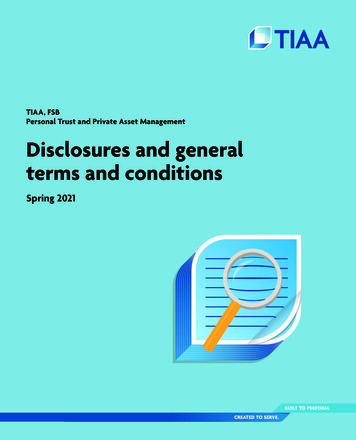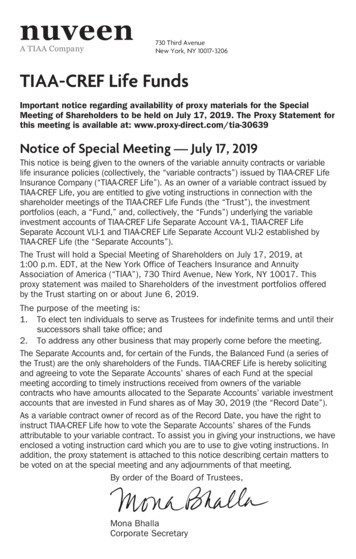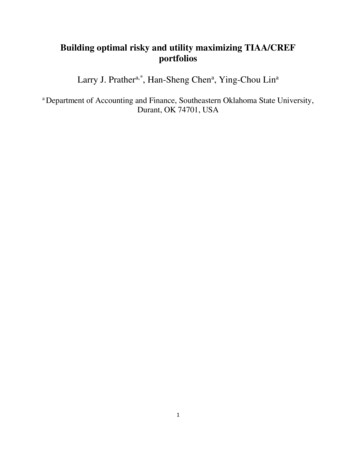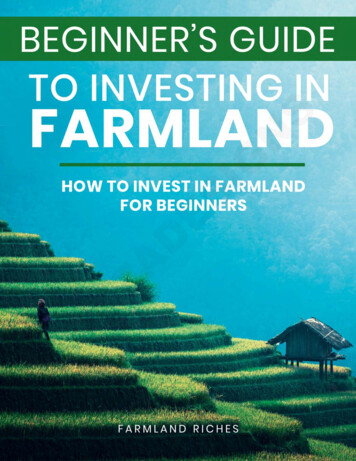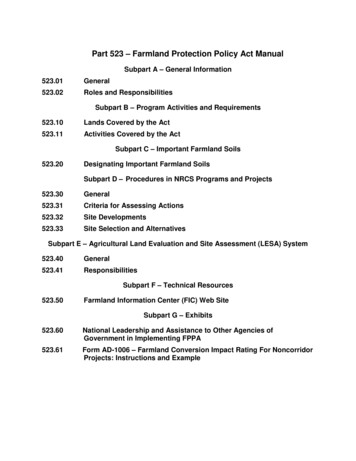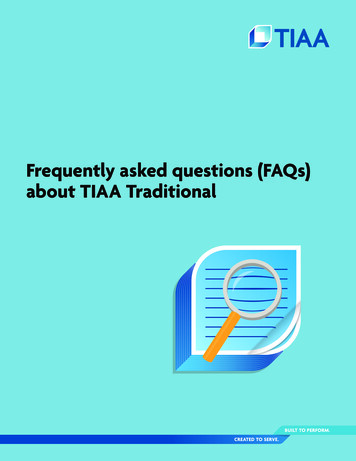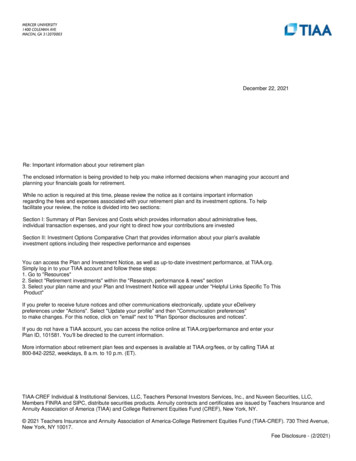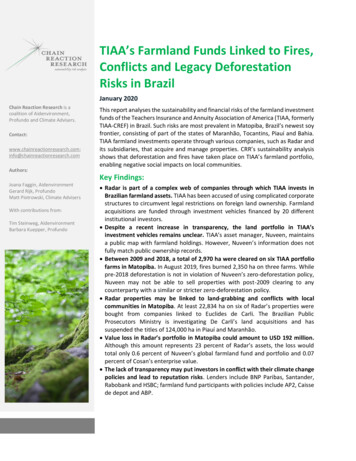
Transcription
TIAA’s Farmland Funds Linked to Fires,Conflicts and Legacy DeforestationRisks in BrazilJanuary 2020Chain Reaction Research is acoalition of Aidenvironment,Profundo and Climate o@chainreactionresearch.comAuthors:This report analyses the sustainability and financial risks of the farmland investmentfunds of the Teachers Insurance and Annuity Association of America (TIAA, formerlyTIAA-CREF) in Brazil. Such risks are most prevalent in Matopiba, Brazil’s newest soyfrontier, consisting of part of the states of Maranhão, Tocantins, Piauí and Bahia.TIAA farmland investments operate through various companies, such as Radar andits subsidiaries, that acquire and manage properties. CRR’s sustainability analysisshows that deforestation and fires have taken place on TIAA’s farmland portfolio,enabling negative social impacts on local communities.Key Findings:Joana Faggin, AidenvironmentGerard Rijk, ProfundoMatt Piotrowski, Climate AdvisersWith contributions from:Tim Steinweg, AidenvironmentBarbara Kuepper, Profundo Radar is part of a complex web of companies through which TIAA invests inBrazilian farmland assets. TIAA has been accused of using complicated corporatestructures to circumvent legal restrictions on foreign land ownership. Farmlandacquisitions are funded through investment vehicles financed by 20 differentinstitutional investors. Despite a recent increase in transparency, the land portfolio in TIAA’sinvestment vehicles remains unclear. TIAA’s asset manager, Nuveen, maintainsa public map with farmland holdings. However, Nuveen’s information does notfully match public ownership records. Between 2009 and 2018, a total of 2,970 ha were cleared on six TIAA portfoliofarms in Matopiba. In August 2019, fires burned 2,350 ha on three farms. Whilepre-2018 deforestation is not in violation of Nuveen’s zero-deforestation policy,Nuveen may not be able to sell properties with post-2009 clearing to anycounterparty with a similar or stricter zero-deforestation policy. Radar properties may be linked to land-grabbing and conflicts with localcommunities in Matopiba. At least 22,834 ha on six of Radar’s properties werebought from companies linked to Euclides de Carli. The Brazilian PublicProsecutors Ministry is investigating De Carli’s land acquisitions and hassuspended the titles of 124,000 ha in Piauí and Maranhão. Value loss in Radar’s portfolio in Matopiba could amount to USD 192 million.Although this amount represents 23 percent of Radar’s assets, the loss wouldtotal only 0.6 percent of Nuveen’s global farmland fund and portfolio and 0.07percent of Cosan’s enterprise value. The lack of transparency may put investors in conflict with their climate changepolicies and lead to reputation risks. Lenders include BNP Paribas, Santander,Rabobank and HSBC; farmland fund participants with policies include AP2, Caissede depot and ABP.
Radar is part of TIAA’s complex web of Brazilian farmland investmentcompaniesRadar Propriedades Agrícolas (Radar) is a Brazilian company established in 2008. Radar was founded asa joint venture between Cosan and Mansilla Participações, with initial capital of USD 400 million. Cosan,a Brazilian company, is active in the energy and logistic sectors. It has a joint venture with Shell (Raízen,from 2011) for production and distribution of sugar and ethanol, and owns ComGás, a subsidiary for thedistribution of natural gas in Brazil. Mansilla is a wholly-owned subsidiary of the Teachers Insurance andAnnuity Association of America - College Retirement Equities Fund (TIAA, formerly TIAA-CREF).In October 2016, Cosan sold an undisclosed share of Radar to Mansilla for BRL 1.06 billion (USD 326million). As a result, Mansilla holds 100 percent of Radar’s preferred shares, while Cosan maintains mostof its ordinary shares. Although TIAA maintains 97 percent of Radar’s capital, Cosan still controls Radarunder Brazilian Law.Radar is part of a complex web of companies through which TIAA invests in global farmland assets.Radar is an intermediary company structured to comply with Brazilian land ownership law. Brazilian Lawlimits foreign ownership to 25 percent of a municipality’s area. Until 2010, companies jointly owned ormanaged by Brazilian and foreign entities were considered to be Brazilian. These companies were notheld to municipality ownership restrictions. However, in 2010, the Brazilian General Counsel’s positionpaper, accepted by the President, proposed that mixed companies (controlled by national andinternational entities) should be considered foreign companies, limiting their land acquisition operations.TIAA has been accused of using complex corporate structures to obscure foreign ownership of landacquisition entities and circumvent these new legal restrictions. After the 2010 regulatory restrictionson land acquisition by mixed companies, Cosan and TIAA established Tellus Brasil Participações (Tellus)specifically for land acquisition (see Figure 1). Through several subsidiaries, such as Terra Viva BrasilParticipações and Nova Gaia Brasil Participações, Tellus is 51 percent owned by Cosan and 49 percent byTIAA, and thus considered a mixed company. Tellus raises funds for farmland purchases throughdebentures to Radar and other subsidiaries. According to TIAA’s quarterly statement, more than 20different companies are listed under indirect or direct ownership and/or management of Radar and Tellusin Brazil. These companies cover operations linked to capital gathering, land acquisition, and the clearing,preparing, leasing, and selling of properties. In 2012, Radar obtained an additional tax ID number to formRadar I and Radar II.A new bill under consideration in the Brazilian Senate proposes to facilitate foreign investments in landacquisitions in Brazil. In May 2019, Senators proposed a new bill for alterations on Article 190 of theFederal Constitution. The proposal calls for the inversion of the 2010 rule. It would recognize companieswith mixed capital or management between Brazilian and foreign companies as Brazilian. The proposalalso increases the limited area that foreign companies can own per municipality’s territory, likely furtheropening Brazil to international investments seeking economic development.TIAA’s Farmland Funds Linked to Fires, Conflicts and Legacy Deforestation Risks in Brazil January 2020 2
Figure 1: Radar and Tellus ownership structureSource: CRR based on TIAA Quarterly Statement (June 2019) and Rede Report on RadarFarmland investments are a key alternative investment strategyTIAA’s asset manager Nuveen has USD 1 trillion assets under management. It considers farmlandinvestments an important pillar of its alternative (USD 97 billion assets under management) investmentstrategy. In 2011, TIAA launched its first Global Agriculture Fund (TCGA I), raising USD 2 billion frominstitutional investors (see Figure 2). In 2015, it launched TCGA II, raising an additional USD 3 billion.Nuveen has unified all farmland asset management under a single firm, Westchester Group InvestmentManagement. With funds from TCGA I, TCGA II, and Mansilla, Westchester controls farmland assets in theUnited States, Australia, Brazil and Chile. The Brazilian entities Radar, Tellus and affiliated entities are allmanaged by the Westchester Group.TIAA’s Farmland Funds Linked to Fires, Conflicts and Legacy Deforestation Risks in Brazil January 2020 3
Figure 2: Institutional investors with a 5 percent or higher stake in TIAA affiliated farmlandinvestment vehiclesTIAA farmlandInvestmentvehiclesTCGA IShareOwner41.7%32.5%TIAA Global AG Holdco LLC - United StatesAndra AP-Fonden (AP2) - SwedenÄrzteversorgung Westfalen-Lippe (AVWL) – GermanyNational Pension Service (NPS) - South KoreaCaisse de dépôt et placement du Québec - CanadaBritish Columbia Investment Management Corporation (BCI) - CanadaAP2 Ag-land Investments KB (AP2) – SwedenTIAA Global AG Holdco LLC - United StatesComptroller of the State of New York, as Trustee of the CommonRetirement Fund (CRF) - United StatesbcIMC Renewable Resource Investment Trust (BCI) - CanadaStichting Pensioenfonds (ABP) – NetherlandsState of New Mexico State Investment Council – United StatesCDP Infrastructures Fund G.P. (Caisse de depot) - United States/CanadaTIAA - United States25%TCGA IIMansilla25%11.67%10%10%6.67%6.67%6.67%100%* Source: SEC Form N-4 Filing (December 2016).Radar’s land holdings lack transparencyDespite recent efforts to increase transparency, Radar’s and its associated companies’ land portfolioremains unclear. Nuveen maintains a public online map with farmland holdings to provide "transparencyin how we pursue sustainable practices through our investments globally.” However, Nuveen’sinformation on its website does not fully match public ownership records.Nuveen’s publicly available farmland map lists 58 properties in Brazil, of which 15 are in Matopiba. Themap lists the tillable area (77,271 ha for the 15 properties in Matopiba) for each farm but does not providethe exact boundaries. Ownership records from the Instituto Nacional de Colonização e Reforma Agrária(INCRA) suggest that Radar and affiliated companies are the registered owners of a total of 111,703 ha ofland.The discrepancy between Nuveen’s reporting and public ownership records are the result of differencesin the tillable reported area of farms and the public ownership registration of these farms, as well asunreported properties. According to INCRA’s records, the total area of the 15 reported farms is 95,067ha. In Nuveen’s portfolio, eight of these farms are linked to TCGA I; four to TCGA II; and three to Mansilla(see Figure 3).TIAA’s Farmland Funds Linked to Fires, Conflicts and Legacy Deforestation Risks in Brazil January 2020 4
Figure 3: TIAA’s reported farmland portfolio in Matopiba (Brazil)Farm nameMunicipalities State123Grão de OuroMarimbondoCatuaí VerdeCorrentina (Bahia)Alto Parnaíba (Maranhão)Balsas (Maranhão)456Catuaí NorteSagitárioLudmila rceirosMandacaruPenitente /PreciosaTotalBalsas (Maranhão)Balsas (Maranhão)Santa Filomena (Piaui)789101112131415Dianópolis (Tocantins)Formosa do Rio Preto (Bahia)Luís Eduardo Magalhães (Bahia)São Desidério (Bahia)Correntina (Bahia)Balsas (Maranhão)Formosa do Rio Preto (Bahia)Balsas (Maranhão)Alto Parnaíba (Maranhão)Tillablearea (ha)Nuveen *5,8482,5186,835Totalarea (ha)INCRA 82510,7943,188Tellus BahiaTellus BrasilToperoneAgrícolaNo InfoTellus BrasilTellus 1,5522,17011,5344,5005,2161,7675,4246189,430No InfoNo InfoAroeiraNo InfoNo InfoNo InfoNo InfoRadarNo Info77,27195,067FundTCGA ITCGA IIMansillaElaborated by CRR in partnership with REDE Social de Justiça e Direitos Humanos. Sources: Nuveen(*) and INCRA(**). All the owners’ companiesare listed in the TIAA-CREF Quarterly Statement (September 2019) and the “no info” status means that it was not possible to confirm the ownershipof the land.Fieldwork and INCRA records also revealed an additional 11 properties in Matopiba with a total area of16,636 ha linked to Radar and its affiliated companies (see Figure 4 and 5). These properties are notlisted on Nuveen’s farmland map. Radar informed CRR that the entire area of five of these farms isregistered as Legal Reserves of other properties listed in its public portfolio (marked in grey in Figure 3),following the Brazilian Forest Code. The other six farms found by CRR were, according to Radar, part ofother properties listed in its public portfolio (Figure 3).Figure 4: Radar’s and Tellus’ farms in Matopiba region of the Cerrado biome (Brazil)1234567891011Farm nameAlegre IAlegre IIRibeirão do MeioSantanaSanta TerezaJanainaPreciosaSão GenaroBrasilGuadalajaraSanta TerezinhaMunicipalities StateSanta Filomena (Piauí)Santa Filomena (Piauí)Riachão (Maranhão)Riachão (Maranhão)Alto Parnaíba (Maranhão)Balsas (Maranhão)Balsas (Maranhão)Balsas (Maranhão)Tasso Fragoso (Maranhão)Tasso Fragoso (Maranhão)Tasso Fragoso (Maranhão)TotalTotal area 6Registered owner*Tellus BrasilTellus BrasilRadarTellus BrasilTellus BrasilRadarRadarRadarRadarRadarRadarElaborated by CRR in partnership with REDE Social de Justiça e Direitos Humanos. Sources: fieldwork and INCRA.TIAA’s Farmland Funds Linked to Fires, Conflicts and Legacy Deforestation Risks in Brazil January 2020 5
Figure 5: Radar’s farms location in Matopiba, Cerrado biome (Brazil)Elaborated by CRR in partnership with REDE Social de Justiça e Direitos Humanos. Sources: fieldwork and INCRA.Within Radar’s portfolio, CRR found nine properties entirely or partially leased to SLC Agrícola (Figure6). Leasing farms to SLC Agrícola in Matopiba is part of Radar’s strategy for increasing the value of theland before selling it and sending the profits to investors who are part of its TCGA’s investment funds. SLCAgrícola does not have a zero-deforestation policy.Figure 6: Radar and Tellus properties leased to SLC Agrícola123456789Farm NameMunicipality (State)Catuaí lajaraSanta TerezinhaGrão de OuroBalsas (Maranhão)Balsas (Maranhão)Formosa do Rio Preto (Bahia)Balsas (Maranhão)Balsas (Maranhão)Tasso Fragoso (Maranhão)Tasso Fragoso (Maranhão)Tasso Fragoso (Maranhão)Correntina 226419666,87536,831Arealeased toSLC (ha) *6,7312,9445,2242,6612,8567366367385,87628,401SLC Farm NameFazenda PlanesteFazenda ParnaíbaFazenda PerceiroFazenda PlanesteFazenda PlanesteFazenda ParnaíbaFazenda ParnaíbaFazenda ParnaíbaFazenda Panorama-InvestmentFundTCGA ITCGA IMansillan.a.n.a.n.a.n.a.n.a.n.a.-*Source: CRR field work in October 2019, Nuveen farm portfolio, and SLC Agrícola farm portfolio.TIAA’s Farmland Funds Linked to Fires, Conflicts and Legacy Deforestation Risks in Brazil January 2020 6
Nuveen is the first farmland investor with a zero-deforestation policyNuveen has a zero-deforestation policy for its farmland investments in Brazil. The policy, adopted inAugust 2018, prohibits new purchases of farmland cleared of native vegetation after predefined cut-offdates. The cut-off dates correspond to the most relevant deforestation protocols for Brazil’s variousbiomes, including the Soy Moratorium, the Grãos Verdes Protocol, and the UN Convention to CombatDesertification. For the Cerrado biome, the date is May 2009 or later in accordance with criteria set forthby the Roundtable for Responsible Soy (RTRS). Nuveen’s sustainability report of 2019 includes a recentESG audit developed by independent organizations covering 30 percent of its properties in Brazil(approximately 101,000 ha out of a total of 338,654 ha). However, the report does not specify where theaudited farms are and if the audit covered its portfolio in the Matopiba region of Cerrado biome.Nuveen’s zero-deforestation policy does not specify any commitments for farms already in its portfolio.Nuveen informed CRR that land acquisition and native vegetation clearing between May 2009 and June2016 in the Cerrado biome was in accordance with criteria put forth by the Round Table on ResponsibleSoy (RTRS) (Brazilian revised version). Nuveen also indicated to CRR that “properties acquired before andafter this date [August 2018] can’t under any circumstances be converted."Catuaí Norte, a 17,825-ha farm in Balsas, Maranhão, provides an example of Nuveen’s compliance ofits zero-deforestation policy. Catuaí Norte is part of TCGA I (see Figure 2) and purchased by WestchesterGroup in 2013. 38 percent of the Catuaí Norte farm is registered as the mandatory Legal Reserve underthe Brazilian Forest Code, although 45 percent is covered by native vegetation. The report says that CatuaíNorte has an “extra preserved vegetation area” of about 1,219 ha (around 7 percent of its total area) inaddition to the Legal Reserve requested by law. Nuveen’s 2019 sustainability report also affirms thatconservation of this “extra preserved vegetation area” is an example of compliance with the objectives ofits zero-deforestation policy, as this area could be legally converted into cropland.2,970 ha of post-2009 deforestation may result in legacy compensationliabilitiesBetween 2009 and 2018, a total of 2,970 ha were cleared on five Radar or Tellus farms in Matopiba (seeFigure 7). Since these farms were already part of Radar’s portfolio in August 2018, the clearing does notviolate the letter of Nuveen’s zero-deforestation policy. No deforestation was detected after the adoptionof the policy in August 2018. However, deforestation between May 2009 and July 2018 took place on twofarms that were in Radar’s possession at the time of the clearing. On one farm, deforestation happenedprior to Radar’s investment. For three farms, the exact acquisition date could not be determined.TIAA’s Farmland Funds Linked to Fires, Conflicts and Legacy Deforestation Risks in Brazil January 2020 7
Figure 7: Post-2009 deforestation on Radar’s farms in Matopiba region of Cerrado biomePurchasing ClearedPerioddateArea (ha)clearanceMay 20121,550 2013-2017Jan 20135502010n.a.6002016Farm NameMunicipality (State)Ludmila / LaranjeirasSagitárioJanaínaSanta Filomena (Piauí)Balsas (Maranhão)Balsas (Maranhão)Tasso Fragoson.a.(Maranhão)Tasso tmentFundTCGA ITCGA In.a.1452016n.a.1252012-2016n.a.2,970-Source: PRODESThe Laranjeiras and Ludmila farms in Piauí saw 1,550 ha of native vegetation clearance after Radar’sacquisition in May 2012 (See figure 8). Radar indicated to CRR that all the native vegetation clearance inLaranjeiras and Ludmila farm were part of its agriculture expansion plan. The Legal Reserve of the Ludmilaand Laranjeiras farms is partially within the property and partially in two remote locations registered asAlegre I and Alegre II (see Figure 9). Radar considers the four farms to be one property. Registration ofLegal Reserves in remote properties is regulated according to the Brazilian Forest Code and by the PiauíForest Law. Radar said that the Legal Reserve is 1,324 ha, when considering the total area of the fourfarms as one property (Ludmila, Laranjeiras, Alegre I and Alegre II). Although the compensation of LegalReserves in other properties is allowed by Law, some discussion currently focuses on its inefficiency inguaranteeing local environmental services. Large areas nearby without native vegetation contribute toshort-term local impacts on biodiversity, water sources, soil nutrition and rainfall. These impacts increasealso the risks of agribusiness operations in the Cerrado biome.In fieldwork CRR conducted in partnership with REDE Social de Justiça e Direitos Humanos in 2019, localcommunities reported impacts linked to the Ludmila and Laranjeiras farms in Santa Filomena, Piauí. Thecommunities close to the Laranjeiras and Ludmila farms reported violent episodes involving people whoused to work with the previous owners of both farms. These conflicts started in 2010 and accelerated in2015, which included burning of local communities’ houses and plantations. Radar declared that, basedon its visit to the area in 2017, it did not find any conflict between the operations within both farms andlocal communities. CRR’s fieldwork also showed that Tellus Brasil, the owner of Ludmila farm, requestedto split its subdivision into three different properties (the farms Piqui, Frutal and Limoeira). It is not clearif this subdivision is linked to selling or leasing plans, which Radar has not confirmed. Local communitiesreported the clearance of native vegetation happening on the Ludmila farm in 2018, which CRR was notable to confirm through satellite images. However, CRR visually confirmed that native vegetationclearance on this farm happened mostly in 2013. Radar reported that it started agriculture operations onthis farm on 2018. The area was most likely abandoned between 2013 and 2018, the period in whichnative vegetation started to regenerate. In 2018, local communities reported that Radar’s operations ledto deforestation.TIAA’s Farmland Funds Linked to Fires, Conflicts and Legacy Deforestation Risks in Brazil January 2020 8
Figure 8: Deforestation in Ludmila and Laranjeiras farms in Santa Filomena, Piauí, in Matopibabetween 2013 and 2017Elaborated by CRR. Imagery by Google Earth and Sentinel-2 imageFigure 9: Registered Legal Reserves and Permanent Preservation Areas of Ludmila, Laranjeiras,Alegre I and Alegre II farms in Santa Filomena, PiauíElaborated by CRR. Imagery by Google Earth and Sentinel-2 image. Sources: INCRA and Serviço Florestal BrasileiroTIAA’s Farmland Funds Linked to Fires, Conflicts and Legacy Deforestation Risks in Brazil January 2020 9
Recent fire events on Radar’s properties in MatopibaRecently, the massive fire events in Brazil received widespread international attention. The Amazon fireevents that started in August 2019 were the largest since 2010 and an increase of almost 80 percentcompared to August 2018. At the same time, fire events also increased in the Cerrado, which registeredmore fire alerts than the Amazon in August 2019. The fires in the Cerrado and the Amazon between Augustand September 2019 were mostly caused by human activity and were exacerbated due to the dry season.Particularly in the Cerrado, the increase of fires has also been a direct consequence of deforestation,which is already causing higher temperatures during dry seasons and worsening fire events. Fires are alsoa direct consequence of deforestation, which is already causing higher temperatures during dry seasonsand in turn worsening fire events.In August 2019, fires burned an area of 2,350 ha on three Radar farms. A recent report by GRAINhighlighted fire events on Harvard University and TIAA farms in Matopiba. Considering only the propertieson which CRR found more than five fire alerts, fire events between August and September 2019 took placeon seven different farms owned by Radar, Tellus, and its subsidiaries in Matopiba. CRR confirmed fireevents on three of these farms in Maranhão: 870 ha in Santana (Riachão), 750 ha in Catuaí Norte (AltoParnaíba), and 730 hectares in Sagitário (Balsas), the last leased to SLC Agrícola (see Figure 10 and 11).Figure 10: Nasa fires alerts from August to September 2019 in Radar’s farms in Matopiba1234567Farm NameCatuaí NorteSantanaGrão de OuroSagitárioAlegre IFlóridaParceirosMunicipality (State)Alto Parnaíba (Maranhão)Riachão (Maranhão)Correntina (Bahia)Balsas (Maranhão)Santa Filomena (Paiuí)Balsas (Maranhão)Formosa do Rio Preto (Bahia)TotalNumber of fires alerts662317171077Investment fundTCGA In.a.TCGA ITCGA ITCGA ITCGA IIMansilla147Source: National Aeronautics and Space Administration (NASA).Figure 11: Fire on the farm Catuaí Norte (left), in Alto Parnaíba (Maranhão) on September 20,2019, and on the farm Santana (right), in Riachão (Maranhão) on August 1, 2019Source: National Aeronautics and Space Administration (NASA).TIAA’s Farmland Funds Linked to Fires, Conflicts and Legacy Deforestation Risks in Brazil January 2020 10
Around 66 fire alerts from August and September 2019 were detected on the Catuaí Norte farm inBalsas, Maranhão. CRR visually confirmed that these fire events resulted in the burning of at least 750 hawithin the Legal Reserve of the farm. Nuveen uses the Catuaí Norte farm as an example of how it preservesnative vegetation in an area larger than what is mandated by the Brazilian Forest Code. Nuveen informedCRR that the fire events in Catuaí Norte were not intentional and that the cleared area will not beconverted to cropland. Even if the fire events were not intentional for conversion to croplands, theyheighten the risk of non-compliance with Nuveen’s zero-deforestation policy and the Brazilian ForestCode, which obliges the restoration of degraded native vegetation on Legal Reserves and PermanentPreservation Areas.Radar may be linked to land-grabbing in MatopibaSix farms totaling 22,834 ha within Radar and Tellus properties’ portfolio may be linked to previousland-grabbing crimes in Southern Maranhão. Between 2010 and 2012, Radar and Tellus bought six farmsin Southern Maranhão from companies owned by or linked to Euclides de Carli (see Figure 12). De Carli isoriginally from São José do Rio Preto, São Paulo, but for decades used a business model based on buying,selling or leasing properties in southern Piauí and Maranhão. He is locally known as one of the biggestland-grabbers in the region. In 2016, a local Agrarian Court suspended the titles of properties totaling 6million ha in Southern Piauí and Maranhão, including 124,000 ha linked to Euclides de Carli. The propertiesnow owned by Radar and Tellus are not among the suspended titles. However, the local Agrarian Courtestimates that de Carli is linked to land-grabbing crimes on areas that total 300,000 ha in Maranhão andPiauí. De Carli is also accused of violence and threats connected to invasions of lands occupied by localcommunities. De Carli died on July 2019 without being convicted in any court cases connected to his landgrabbing. He is still registered as the owner of 16 different companies in Maranhão.Figure 12: Radar and Tellus properties bought from companies owned by or affiliated withEuclides de Carli12345Area(ha)AcquisitionBalsas (Maranhão)3612010Balsas (Maranhão)Alto lsas (Maranhão)10,7942011Laranjeirasand LudmilaSanta Filomena(Piauí)2,3882012Farm NameMunicipality (State)São GenaroPreciosaMarimbondoTotal22,834-SellerCodeca - Colonizadorade CarliAgropecuária oImobiliária Terra doSol-OwnerTellus BrasilTellus BrasilRadarRadarTellus BrasilInvestmentFundn.a.n.a.TCGA ITCGA ITCGA I-Source: CRR field work October 2019 and Brazilian Tax Office database.Radar properties are linked to previous social and environmental impacts and direct threats to localcommunities in Santa Filomena, Piauí. In 2012, Radar acquired the farms Laranjeiras and Ludmila in SantaFilomena, Piauí, from Imobiliária Terra do Sol, owned by Tellus Brasil. The previous owner of the area wasSimone de Carli, possibly a relative of Euclides de Carli. The conflicts in the area started in 2010, when deCarli invaded local community’s territory and claimed the title of the area where currently both farms are.In 2015 and 2016, after the farms were bought by Radar, a local community reported that people linkedTIAA’s Farmland Funds Linked to Fires, Conflicts and Legacy Deforestation Risks in Brazil January 2020 11
to de Carli set fire to one of the community’s houses near the farms. Environmental impacts are also aconcern to local communities. Radar’s Laranjeiras and Ludmila farms are in the highlands or plateaus, andthe communities usually live in the low land close by the water sources. Local communities report,however, that the plateaus areas are used for harvesting fruits and herbs and for seasonal animalbreeding. As a result, the local communities must contend with a scarcity of water sources; a decrease ofwater quality due to agrochemicals; health problems caused by the consumption of water from localrivers; impacts on the local fauna (fish); and land degradation. Over the long term, these impacts alsothreaten food and agricultural production. Radar told CRR that it recognizes some of the externalitieshighlighted by local communities, but pointed out that its operations in the region bring also somebenefits such as employment, infrastructure and small projects that support communities’ development.Sustainability risks may result in legal, operational and stranded land risksRadar’s business model of investing in farmland in the Brazilian Matopiba region includes legal,operational and stranded land risks. Sustainability risks in Radar’s business model in Matopiba includedeforestation after 2009, recent fire events and potential links to previous land- grabbing cases withimpacts on local communities’ livelihood. The exposure of Radar’s business model to these risks mayimpact TIAA and other investors in the TCGA I and TCGA II funds.Radar may see legal risks from its potential links to previous land-grabbing cases in the Matopiba regionin the Cerrado biome. CRR found at least six farms within Radar’s Matopiba portfolio bought fromcompanies under investigation for being part of one of the largest land-grabbing schemes in the region.These land-grabbing cases are linked to social and environmental impacts that directly affect thelivelihood of local communities, possibly exposing Radar to legal risks. In the investigation of these landgrabbing schemes in the Matopiba region, Radar may see fines, legal fees or even to the loss of titles ofits properties in the region.In addition, Radar may face operational risks at farms linked to social and environmental impacts. Socialimpacts reported by local communities are linked to both Radar’s buying of land and operations of onthose lands in the Matopiba region. These social impacts could increase amid demand for new areas as aresult of the government's programme for agribusiness development of Matopiba region, started in 2015,with facilitated loans and credits for crop production in the area. Moreover, demand could also risebecause of the after-effects of the 2008 financial crisis, which spurred Brazilian agribusiness to expand itsproduction area. The pressure for opening new production areas, especially in the expansion frontier ofMatopiba, has had immediate effects on local communities’ livelihood, including violence, landdegradation, water source scarcity and pollution. In the medium to long term, environmental impactsreported by local communities may also compromise large-scale agriculture development in the region.While the pre-2018 deforestation reported above is not in violation of Nuveen’s zero-deforestationpolicy, it may nonetheless pose future compensation or s
funds of the Teachers Insurance and Annuity Association of America (TIAA, formerly TIAA-CREF) in Brazil. Such risks are most prevalent in Matopiba, razil's newest soy frontier, consisting of part of the states of Maranhão, Tocantins, Piauí and Bahia. TIAA farmland investments operate through various companies, such as Radar and
